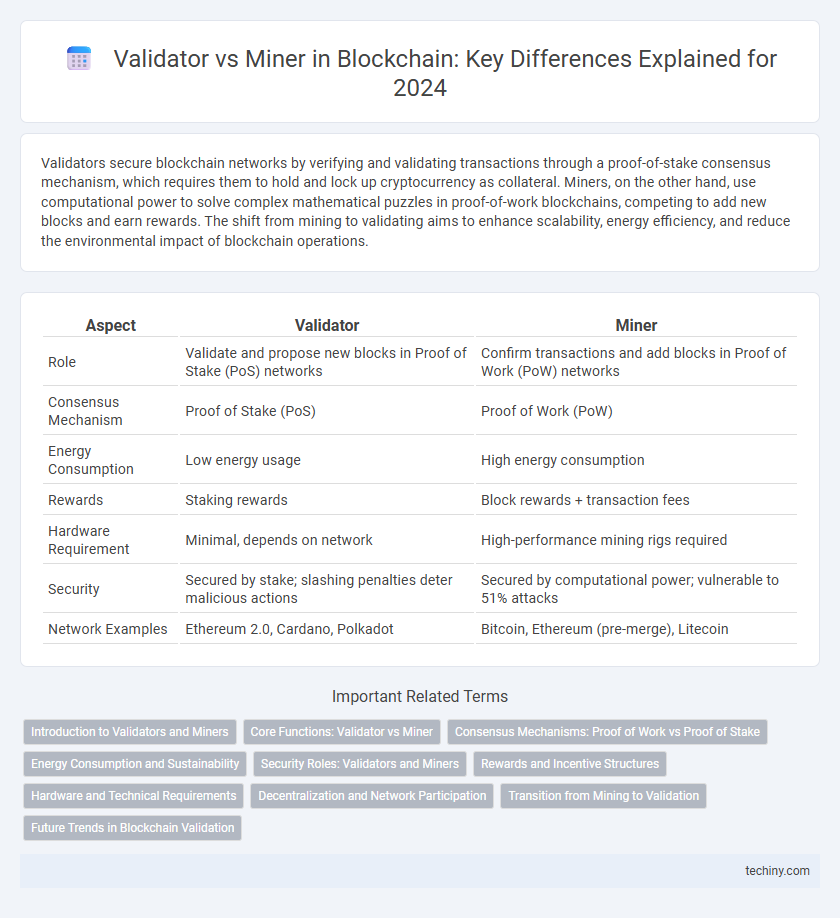Validators secure blockchain networks by verifying and validating transactions through a proof-of-stake consensus mechanism, which requires them to hold and lock up cryptocurrency as collateral. Miners, on the other hand, use computational power to solve complex mathematical puzzles in proof-of-work blockchains, competing to add new blocks and earn rewards. The shift from mining to validating aims to enhance scalability, energy efficiency, and reduce the environmental impact of blockchain operations.
Table of Comparison
| Aspect | Validator | Miner |
|---|---|---|
| Role | Validate and propose new blocks in Proof of Stake (PoS) networks | Confirm transactions and add blocks in Proof of Work (PoW) networks |
| Consensus Mechanism | Proof of Stake (PoS) | Proof of Work (PoW) |
| Energy Consumption | Low energy usage | High energy consumption |
| Rewards | Staking rewards | Block rewards + transaction fees |
| Hardware Requirement | Minimal, depends on network | High-performance mining rigs required |
| Security | Secured by stake; slashing penalties deter malicious actions | Secured by computational power; vulnerable to 51% attacks |
| Network Examples | Ethereum 2.0, Cardano, Polkadot | Bitcoin, Ethereum (pre-merge), Litecoin |
Introduction to Validators and Miners
Validators in blockchain networks are entities responsible for verifying transactions and maintaining consensus through a proof-of-stake mechanism, ensuring security and preventing double-spending. Miners use computational power to solve complex mathematical problems in proof-of-work systems, adding new blocks to the blockchain and earning rewards for their efforts. Both validators and miners play crucial roles in transaction validation and network integrity but operate under distinct consensus protocols with different resource requirements.
Core Functions: Validator vs Miner
Validators confirm and finalize transactions by proposing and voting on new blocks in proof-of-stake (PoS) networks, ensuring network consensus without extensive computational work. Miners solve complex cryptographic puzzles to add new blocks to proof-of-work (PoW) blockchains, securing the network through significant energy consumption. While miners compete to validate transactions, validators collaborate, reflecting distinct consensus mechanisms that impact scalability and energy efficiency.
Consensus Mechanisms: Proof of Work vs Proof of Stake
Validators participate in consensus mechanisms through Proof of Stake (PoS), where they lock up cryptocurrency as collateral to validate transactions and create new blocks, enhancing energy efficiency and scalability. Miners operate in Proof of Work (PoW) systems by solving complex cryptographic puzzles to secure the network and confirm transactions, requiring significant computational power and energy consumption. PoS consensus prioritizes economic incentives and lower environmental impact, while PoW emphasizes network security through computational difficulty and resource expenditure.
Energy Consumption and Sustainability
Validators in blockchain networks rely on proof-of-stake (PoS) mechanisms, drastically reducing energy consumption compared to miners who use proof-of-work (PoW) protocols demanding intensive computational power. PoS validators secure the network by locking tokens, resulting in sustainable operations with minimal carbon footprint. In contrast, PoW mining involves continuous, high-energy hardware activity that contributes to significant environmental impact and energy waste.
Security Roles: Validators and Miners
Validators secure blockchain networks by verifying and validating transactions through consensus mechanisms like Proof of Stake, ensuring data integrity and network trust. Miners contribute security by solving complex cryptographic puzzles in Proof of Work systems, adding new blocks and preventing double-spending attacks. Both roles are critical for transaction validation and maintaining the blockchain's decentralized security architecture.
Rewards and Incentive Structures
Validators earn rewards through staking cryptocurrencies in Proof of Stake (PoS) networks, receiving transaction fees and newly minted coins proportional to their staked amount. Miners compete to solve complex cryptographic puzzles in Proof of Work (PoW) systems, earning block rewards and transaction fees for validating blocks. The incentive structure in PoS emphasizes energy efficiency and long-term commitment, whereas PoW incentivizes computational power and energy consumption.
Hardware and Technical Requirements
Validators in blockchain networks typically require less energy-intensive hardware, relying on standard servers to run staking nodes, as their role involves validating transactions based on stake rather than solving complex algorithms. Miners, on the other hand, need high-performance, specialized hardware such as ASICs or powerful GPUs to perform computationally intensive proof-of-work calculations, which demand significant electricity and cooling resources. The technical requirements for validators emphasize network uptime and security encryption, while miners prioritize hash rate capacity and hardware efficiency to maximize block rewards.
Decentralization and Network Participation
Validators and miners both secure blockchain networks, but validators on Proof of Stake (PoS) systems enhance decentralization by allowing broader network participation with lower entry barriers compared to miners in Proof of Work (PoW) systems, which require significant computational power and energy. PoS validators are selected based on the stake they hold, promoting inclusive consensus and reducing centralization risks associated with mining pools dominating the network. The shift from mining to validating supports scalable and energy-efficient blockchain ecosystems with diverse participants, strengthening overall network security and decentralization.
Transition from Mining to Validation
The transition from mining to validation in blockchain technology reflects a shift from energy-intensive Proof of Work (PoW) consensus algorithms to more sustainable Proof of Stake (PoS) mechanisms. Validators replace miners by staking cryptocurrency to secure the network, verify transactions, and produce new blocks without requiring massive computational power. This transition enhances scalability, reduces environmental impact, and strengthens network security by aligning economic incentives with honest behavior.
Future Trends in Blockchain Validation
Validators in blockchain networks are increasingly replacing miners as the primary actors in consensus mechanisms, driven by the shift from proof-of-work (PoW) to proof-of-stake (PoS) models. Future trends indicate that validator roles will expand with advancements in scalability solutions like sharding and layer-2 protocols, enhancing transaction throughput and energy efficiency. Emerging blockchain platforms prioritize validator decentralization and robust staking incentives to secure networks while promoting sustainability and reduced carbon footprints.
Validator vs Miner Infographic

 techiny.com
techiny.com